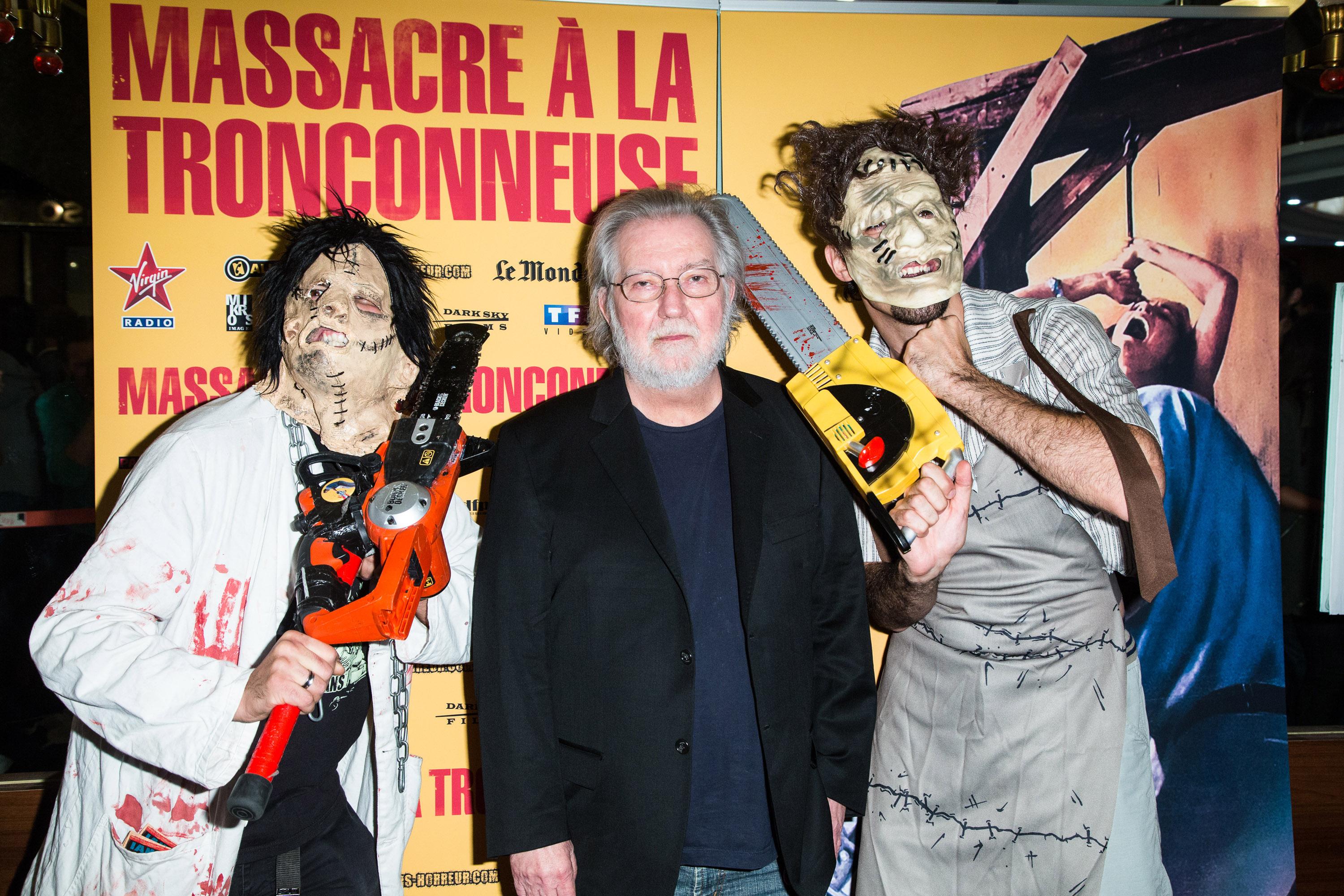
A gnarled, decomposing hand. A dripping, akimbo corpse. A bloody moon. A roadstruck armadillo. A man in a wheelchair urinating into a coffee can. The macabre and the cruelly funny commingled in the opening images of The Texas Chain Saw Massacre and throughout the films and television work of the writer-director Tobe Hooper, who died on Saturday at 74.
Hooper and his cowriter Kim Henkel called the manner in which they constructed the story of Texas Chain Saw “nightmare syntax.” It’s a flashing, strangulating style that created a template for thousands of horror filmmakers, but was never replicated. Six years removed from George Romero’s Night of the Living Dead, a movie he adored, and five years out from his flop feature-film debut, Eggshells, Hooper set about to make something pulpy, furious, claustrophobic, and family-oriented. And successful. Growing up in Texas and Louisiana, Hooper told the journalist Jason Zinoman in his horror history Shock Value, “Those family dinners can go very wrong. I saw some things growing up that were bizarre and weird.” That feeling, built around a loose inspiration by the Wisconsin serial killer Ed Gein, led to Leatherface and the Sawyer family.
Leatherface — a chainsaw-wielding, skin-masked maniac — redefined monsters at the movies, removing the stigma of evil and replacing it with a childlike fear and obsession. The Sawyers were all laid off from their jobs at the local slaughterhouse, and the family makes do feeding their visceral desires by slaughtering and ultimately eating the human beings who find their way to their remote, entrails-stained Texas home. The youthful, wounded pain that drives Leatherface — who Hooper has said was developmentally disabled — to kill predates Michael Myers in Halloween, Jason Voorhees in Friday the 13th, and dozens of other masked slashers. That isn’t all that Hooper perfected. In Sally Hardesty (played by the actress Marilyn Burns), Hooper solidified horror’s “final girl” trope. With its serious, documentary-style opening scroll and whirling dervish camera movement, he also laid claim to a sort of “found footage” decades before we called it that. (Though the film is actually meticulously staged.) In a filmmaking era that defined influence, few were copied as often as Hooper’s masterpiece.
Texas Chain Saw was preceded by the rumblings of a golden age of terror innovation made by intellectuals and movie brats, which included The Exorcist, Last House on the Left, A Clockwork Orange, and eventually Carrie and Halloween. Hooper, a devotee of EC Comics and Hammer horror movies, was a little bit different. His movies seeded ideas about Vietnam and familial tragedy, but they were never strictly about them. He wanted to wreck audiences’ state of grace. He did at least once. Chain Saw, on a budget that has been reported somewhere between $100,000 and $300,000, turned his relentless and flesh-ripping movie into a sensation, grossing more than 100 times its budget since its initial release. It is also his greatest legacy.
In the years to come, his films were interesting, but often inconsistent. The campy, Jaws-baiting follow-up to Chain Saw was Eaten Alive, a killer-crocodile-meets-slasher movie that somehow looked flimsier than his micro-budgeted success. The Funhouse, a carnival killer movie, improves on the production value, if not the storytelling. (In between the two came the fascinating, slow TV miniseries adaptation of Stephen King’s Salem’s Lot, one of the better King adaptations that features the best vampire entrance I’ve ever seen.) The controversy of his next film overwhelms some parts of the legacy he forged with Chain Saw. Hooper’s Poltergeist was written and produced and maybe, possibly, sort of codirected by Steven Spielberg. Though contractually disallowed from shooting another movie while he worked on E.T. the Extraterrestrial, Spielberg spent several days on set with Hooper and the cast and crew. After some comments he made to the press — namely, “Tobe isn’t … a take-charge sort of guy. If a question was asked and an answer wasn’t immediately forthcoming, I’d jump in and say what we could do. Tobe would nod agreement, and that became the process of collaboration” — a controversy of authorship was kicked up. Some actors sided with Hooper, some crew and executives with Spielberg. The truth is, it doesn’t matter who did what on set — Poltergeist is a perfect fusion of Hooper’s gruesome, vivisecting vision and Spielberg’s intimate, filial obsessions. Poltergeist was a hit and a rare pop confection that also featured a man tearing the flesh from his own face.
It would mark the last of Hooper’s hits, though not the last time he made something so fascinating. For the next 30 years, Hooper continued to tell horror stories, iterating on the Chain Saw mythology with a woebegotten sequel, returning to slashers and crocodiles over the years. For years, he has been a scaremeister emeritus, with his best work deep in the rearview.
But there is one outlier: If you have not seen Lifeforce, please see Lifeforce. Produced by the lords of schlock Menachem Golan and Yoran Globus’s Cannon Films, Hooper was given a $25 million budget and what he described as “free rein” to film Alien cocreator Dan O’Bannon and Don Jakoby’s adaptation of Colin Wilson’s sci-fi novel Space Vampires. It must be seen to be believed. Mixing equal parts zombie movie, sexploitation comedy, chin-stroking science fiction, and apocalyptic disaster picture, and featuring Patrick Stewart and a rousing Henry Mancini score, Lifeforce is Hooper unbridled. It bombed, badly. This memorable, gleefully gobsmacked Leonard Maltin review of the movie sums up the public’s reaction fairly well. “Now, am I saying this is a good movie? No way! But …” Maltin would say, before going on to recommend Lifeforce as a vehicle for buttery popcorn consumption and backslapping laughs. No way! But … It’s a fitting encomium for a filmmaker who worked with his guts out, unbothered by pretension, desperate to entertain at all costs. He’d give you the skin off his face for a great scare.

